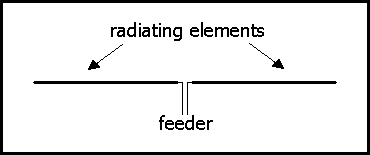
The antenna (aerial) is the device that actually converts the electrical signals to radio waves and vice versa. When we are transmitting electrical signals arriving in the antenna through the feeder are converted into radio waves. When receiving the radio waves arriving at the antenna are converted into electrical signals which travel down the feeder to the receiver.
There are many different types of antenna, each with its own special characteristics, but for the purposes of the Foundation Licence course we need only be familiar with four basic types, dipole, vertical, end-fed and yagi. Each antenna design has its own characteristics which we may utilise to obtain the desired result in a given situation, however sometimes our antenna choice will be dependant more on non-radio factors such as available space and visual impact considerations. As you gain experience in operating it will become easier for you to decide which antenna to use and when, you will also come across many other antenna designs. If you progress to the higher licence classes you will learn much more about antennas.
Antennas are designed for one particular frequency (or wavelength). It's physical dimensions are proportional to the wavelength for which it is designed, so a dipole for the 80m (3.5Mhz) band will be much larger than a dipole for the 6m (50MHz) band.
A half-wave dipole consists of a wire half a wavelength long, usually broken in the middle. It will only give a low SWR, and only radiate efficiently if it is exactly half a wavelength long at the frequency in use, and both sides, called "arms" in this case, must be of equal length.

At VHF (50MHz and above) it is often mounted vertically. In this configuration it will radiate (and receive) equally in all directions. It is said to be "omni-directional", and provides a good basic antenna for local communications.
At lower frequencies it is more often mounted horizontally. The horizontal dipole radiates from the sides of the dipole, at right angles to the arms, with very little radiation off the ends. Here it is said to be bi-directional. Obviously it will need to be positioned carefully to take this directivity into account.